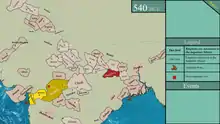Kingdom of Kashi
The Kingdom of Kashi was an ancient Indian kingdom located in the region around its capital Varanasi, the latter bounded by the Varuna and Asi rivers in the north and south and named after them. It was one of the sixteen Mahajanapadas, great states that emerged in northern India at the start of the 6th century BCE. The kingdom of Kashi was bigger than Varanasi. Its easternmost border was the Son River, which was also the western border of erstwhile Magadh. It would have covered much of the area of Eastern UP centered around today's Varanasi and the contemporary southwestern part of Bihar that was Arrah (Shahabad) district. Today this area comprises Bhojpur, Rohtas, Kaimur and Buxar districts. Technically, the territory of Kashi today would dominated by people of the Bhojpuri language and culture. Kashi Mahajanpad would still be larger than what is covered within the Panch Krosh Kashi, as defined in the Puranas.
Kingdom of Kashi | |||||||
|---|---|---|---|---|---|---|---|
.png.webp) Kashi and other kingdoms of the late Vedic period. | |||||||
.png.webp) Kashi and other Mahajanapadas in the Post Vedic period. | |||||||
| Capital | Varanasi | ||||||
| Religion | Hinduism Buddhism Jainism | ||||||
| Government | Monarchy | ||||||
| |||||||
| Outline of South Asian history |
|---|
_without_national_boundaries.svg.png.webp) |
At the time of Chanakya, Kashi was still the center of Vedic and secular education par excellence, despite the prominence of Magadh. It was known more for military prowess. While Varanasi came under Buddhist influence, Shahabad remained a dominion of Hindu Shaivite culture, as reported by Chinese pilgrims.
The Jataka tales indicate Varanasi was one of the richest cities in India, known for its prosperity and opulence.[1] These stories tell of a prolonged rivalry between the neighboring kingdoms of Kashi and Kosala, with also some occasional conflict with Anga and Magadha. Kashi once was one of the most powerful states in north India.[1] Although King Brihadratha of Kashi conquered Kosala, during Buddha's time Kashi was incorporated into Kosala by King Kansa.[2] The Kashi, along with the Kosala and Videhan, are peoples mentioned in Vedic texts and appear to have been closely allied.
Siddartha Gautama first started preaching Buddhism in Kashi territory.
 Kashi coin, 400-300 BCE.
Kashi coin, 400-300 BCE. Map depicting 16 mahajanapadas kingdoms and other kingdoms of vedic era India in 540 BCE.
Map depicting 16 mahajanapadas kingdoms and other kingdoms of vedic era India in 540 BCE.
References
- Singh, Upinder (2008). A history of ancient and early medieval India: from the Stone Age to the 12th century. Pearson Education. pp. 258–262. ISBN 9788131711200.
- https://sreenivasaraos.com/tag/history-of-kashi/